From the December 2022 issue of Apollo. Preview and subscribe here.
The Adoration of the Shepherds by Domenico Ghirlandaio is one of the finest examples of the artist’s work. Jean Cadogan explains how the painting nods to its patron and why it is so packed with people.
Francesco Sassetti (1421–90), who commissioned the painting, spent his whole life in the service of the Medici bank. He was a humanist, he certainly read Latin, and he had a very extensive library. One of the primary goals, not just of humanists, but of Christian theologians over time, was to try to reconcile Christianity with paganism. He was also a collector – he collected coins and inscriptions, so he was very interested in the culture of pagan antiquity.
There’s a long history of Sassetti patronage in Florence, about which Aby Warburg wrote a famous essay. Traditionally, Sassetti family tombs were in Santa Maria Novella, the Dominican church on the west side of Florence – but Sassetti patronage at Santa Maria Novella lapsed. We do know that Sassetti tried to revive it, but he had a rival in Giovanni Tornabuoni (1428–97), who was also working at the Medici Bank. Tornabuoni had the upper hand; he was the uncle of Lorenzo the Magnificent, and he also had a lot more money than Sassetti. So, having lost that struggle, Sassetti turned to Santa Trinità to have his tombs and his family chapel established there.
Sassetti was negotiating the rights to the chapel in the late 1470s, though he probably didn’t commission Domenico Ghirlandaio (1448/49–94) till the early 1480s. A recently published family memoir of the artist states that he began painting the chapel in June 1483. That means he would have finished it fairly quickly, at the end of 1485. By then, Ghirlandaio was a known quantity. His workshop had been tasked with decorating one of the great assembly rooms in the Palazzo Vecchio, a civic commission, with which Lorenzo de Medici seems to have been involved. He had also built a reputation outside of Florence; he was part of the group that went to paint at the Sistine Chapel in 1481–82. And he had painted for other important families: the family of Ser Amerigo Vespucci, the uncle of the navigator for whom America is named, and his son Giorgio Antonio Vespucci; and indeed Giovanni Tornabuoni, for whom Vasari says Ghirlandaio had painted the burial chapel of his wife Francesca Pitti Tornabuoni in Santa Maria sopra Minerva, Rome, in the late 1470s. So it could be that Sassetti, seeing his rival employ Ghirlandaio, was motivated to do so himself.
It’s important to view the altarpiece as part of the ensemble of the Sassetti Chapel. On the outside of the chapel, above the entrance arch and to the left, there are murals, one of which – a pointed, arch-shaped lunette above the entrance arch – shows the story of the vision of the emperor Augustus. This was interpreted by the Tiburtine Sibyl as foretelling the birth of a child that will herald an era of peace. The idea of Christianity supplanting the pagan world of antiquity was very common at the time.
The murals themselves show scenes from the life of Saint Francis. Ghirlandaio depicts some of the standard scenes, all of which relate to this idea of prophecy and rebirth. But there is also, for the main scene on the altar wall, a depiction of the resurrection of the notary’s son. This is not an episode you’d find at Assisi; the story is that a young child, son of a notary, fell out of a window and was killed, before Saint Francis resurrected him.
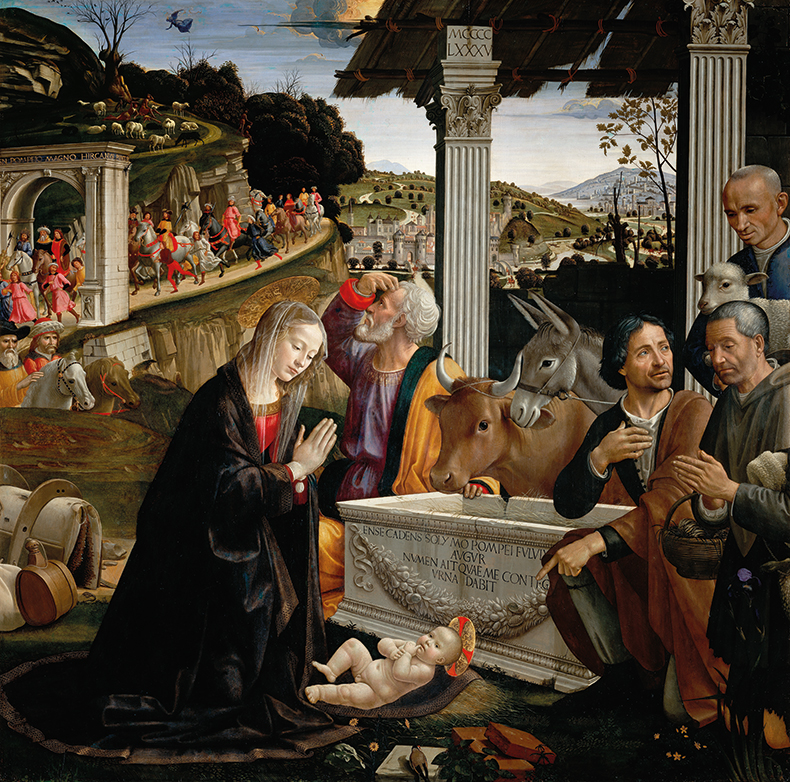
Adoration of the Shepherds (1485), Domenico Ghirlandaio. Santa Trinità, Florence. © 2022 Photo Scala, Florence
All of these ideas of birth, rebirth and resurrection are tied together in the altarpiece. But the painting is also remarkable for its style. Even in his earliest works, Ghirlandaio showed an interest in Flemish painting. There’s a very early, poorly preserved mural in Ognissanti, painted for Ser Amerigo Vespucci at the beginning of the 1470s. It’s quite clear, not just from the composition but the individual figures, their movements, even – he has tears dripping down their cheeks! – that this is all very much inspired by Flemish painting, which was in great vogue in Florence. In May 1483 – almost exactly the moment Ghirlandaio starting painting the chapel – Hugo van der Goes sent his Portinari altarpiece, likewise depicting the adoration of the shepherds, to Florence. Everybody was just agog – as people are agog to see it in the Uffizi today.
The Italian tradition always has this classical tendency to idealise, to choose the most beautiful examples of figures. So Van der Goes’ work was surprising to people, and Ghirlandaio was definitely playing on that – especially in the remarkable shepherds on the right-hand side, in the foreground. Look at the shepherd standing on the far right with his prominent nose and lips – you would never find that in Fra Angelico, or Masaccio, or Lippi – any of the prominent painters from the middle of the 15th century. Still, if you do a one-to-one comparison with Van der Goes, Ghirlandaio has certainly softened these features, made them a little less rugged.
The painting is beautifully preserved, and we can probably say that Ghirlandaio used his usual method for painting flesh, which is quite traditional Florentine. He uses a gesso ground, and for the flesh tones he then paints an underlayer of terra verde (green earth). For the top layer he applies his paint with point of the brush, using a rosy red pigment, probably vermilion with lead white. This is basically tempera, though he does use admixtures of oil as well to apply some pigments.
Because Ghirlandaio is using tempera, the areas are fairly strictly defined with sharp contours – essentially he would treat these almost as the daily patches (giornate) of a fresco, treating each area individually depending on the pigment he was going to use. If you look at the face of the Virgin, or Saint Joseph, or one of those shepherds, Ghirlandaio never really lets go. The faces are painted incredibly carefully; if you look closely at them, you see a mesh, from the point-of-the-brush strokes, either in parallel or cross-hatched. In this, he’s quite unlike the Flemish painters. Oil allowed artists like Van Eyck to eliminate the trace of the single brushstroke and fuse these strokes into an area, a whole surface of tone. Ghirlandaio never avails himself of that – he seems not to have wanted to. This meticulous point-of-the-brush execution – I think it was his signature. If you put a face like the Saint Joseph here next to a face by Hugo van der Goes, the latter is always going to be more naturalistic. This is what softens somewhat our impression of Ghirlandaio’s shepherds.
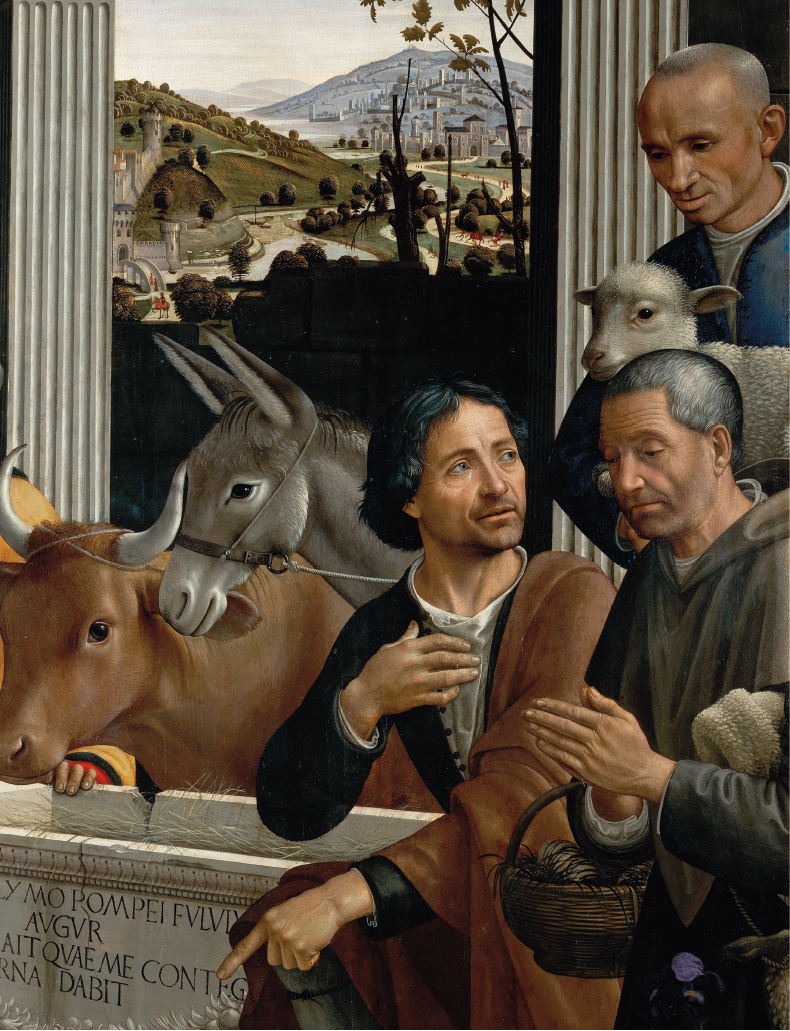
Adoration of the Shepherds (detail; 1485), Domenico Ghirlandaio. Santa Trinità, Florence. © 2022 Photo Scala, Florence
Perhaps the main thing that sets this altarpiece apart from other nativities is the density with which it is packed not only with everyday objects, but also reconstructions of the tangible remains of antiquity – like the sarcophagus, the triumphal arch and those fluted piers that hold up the manger. The inscription on the triumphal arch reads: ‘The priest Hyrcanus erected [this arch] in honour of Gnaius Pompey the Great.’ This refers to a passage from The Wars of the Jews by Josephus, which relates how an arch was put up in Jerusalem to thank Pompey for not sacking the temple in AD 70. So again, this alludes to the triumph of Christianity over Judaism. The cortege of the Magi enters through the triumphal arch as would a victorious army; the adoring Magi recognised the new-born Christ as king. The city of Rome is depicted above Saint Joseph; Jerusalem is also shown on the right. On the sarcophagus the inscription relates again to Pompey. His augur Fulvius, as he fell before Jerusalem, claimed, ‘My tomb will produce a new deity’. Again, there’s this idea of prophecy – from the old comes the new. Sarcophagi had huge prestige, as Sassetti would have been aware.
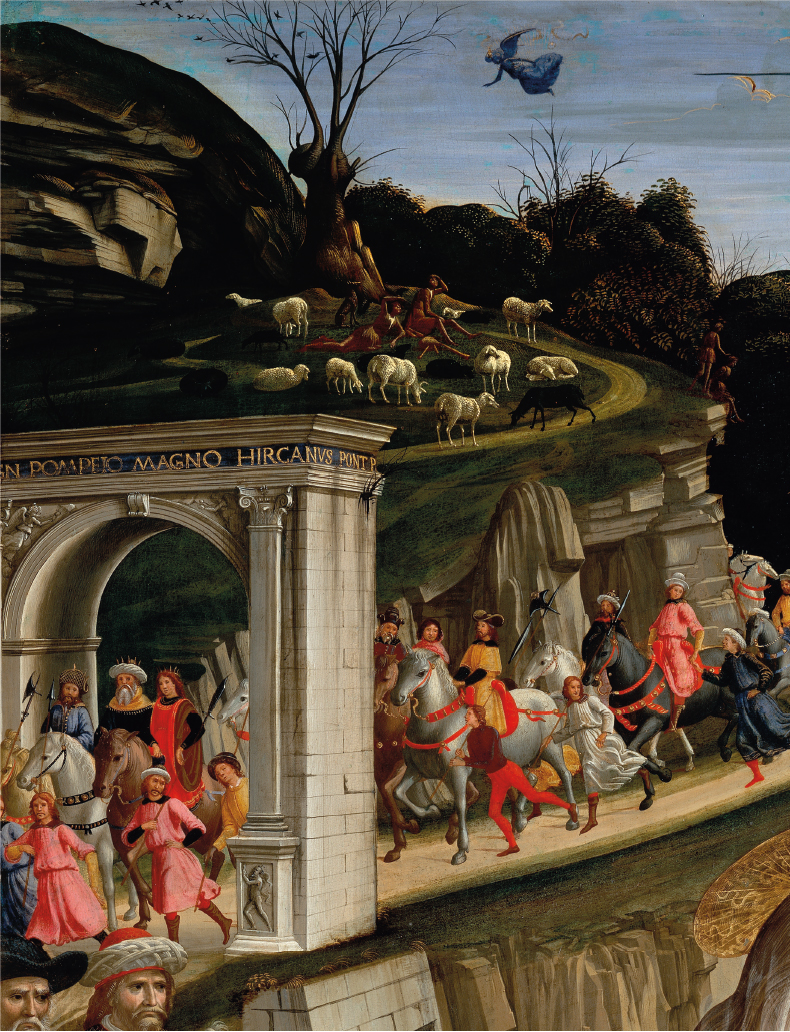
Adoration of the Shepherds (detail; 1485), Domenico Ghirlandaio. Santa Trinità, Florence. © 2022 Photo Scala, Florence
The little vignette of the annunciation to the shepherds at the top left is absolutely beautiful. It’s painted in ultramarine blue with touches of gilding. Joseph has a peculiar position in nativities; here, he acknowledges this scene with this great gesture to his forehead and his really beautifully foreshortened hand. Again, this miraculous event is echoed throughout the imagery of the rest of the chapel.
There is a still life in the foreground. The whole idea of endowing everyday objects with meanings beyond their obvious, prosaic ones is something in which the Flemings really specialised. Here, the big stone is a reference to Sassetti’s name; the word ‘sasso’ in Italian means stone, of which Sassetti is a diminutive.
The goldfinch is a reference to the Passion, and the bricks probably allude again to classical buildings. The manger itself has beautiful fluted piers supporting a dilapidated wooden roof. This juxtaposition of the new with the old and decrepit embeds a sense of the passage of time into the painting. This is not just a snapshot – there are all these allusions to what came before and what comes afterwards.
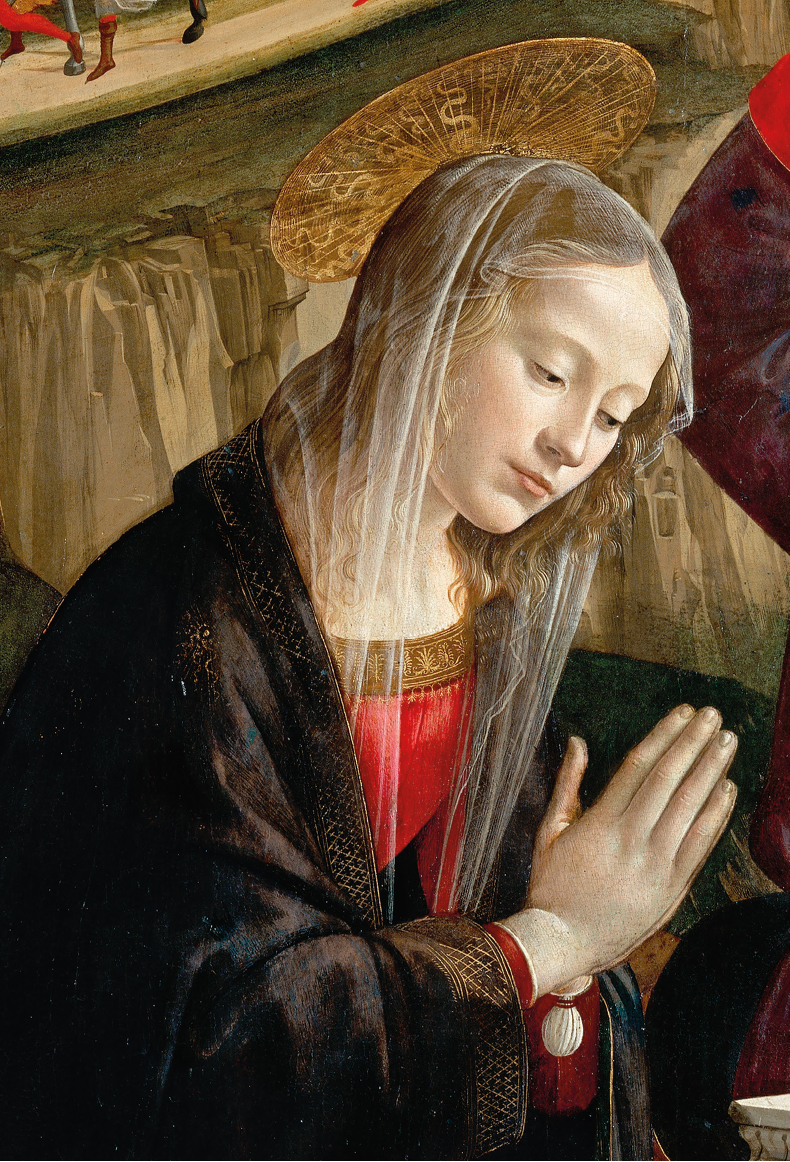
Adoration of the Shepherds (detail; 1485), Domenico Ghirlandaio. Santa Trinità, Florence. © 2022 Photo Scala, Florence
The arrangement of the Virgin and Child comes from 14th-century devotional literature, which describers the Virgin adoring the Child, who lies on a bed of straw on the ground. The inscription on the original frame of the painting reads, ‘Mary adored the One whom she had borne.’ This figure group is what Hugo van der Goes used as well. Ghirlandaio has placed the Christ Child in the centre and lined up Saint Joseph with the Virgin leaning in – these three form a nodal point for the composition, and this is typical of Ghirlandaio, who always seeks to make his compositions very solid, looking for balance and stability. But he also seeks to weave these figures together into a narrative. He is aiming to differentiate all the figures, but also knit them into a central focus. Here the Virgin and Child are the centre, the shepherds and the ox and ass lean in from the right, while in the background the cortege of the Magi converges on the centre from the left.
This painting is a very important work in Ghirlandaio’s career. It was a chance to cement his reputation – a central site in Florence, very accessible to people, a prestigious patron – and it was a very good advertisement for future patronage. He really put a lot of effort into this altarpiece, which seems 100 per cent autograph to me. It was finished in December 1485. Only three months previously, in September 1485, Giovanni Tornabuoni signed a contract commissioning Ghirlandaio to paint the main chapel in Santa Maria Novella – an even more prestigious site for an even more prestigious patron. So his gamble paid off.
As told to Samuel Reilly.
Jean Cadogan is professor of fine arts at Trinity College, Hartford, and the author of Domenico Ghirlandaio: Artist and Artisan (Yale University Press).
From the December 2022 issue of Apollo. Preview and subscribe here.
Unlimited access from just $16 every 3 months
Subscribe to get unlimited and exclusive access to the top art stories, interviews and exhibition reviews.

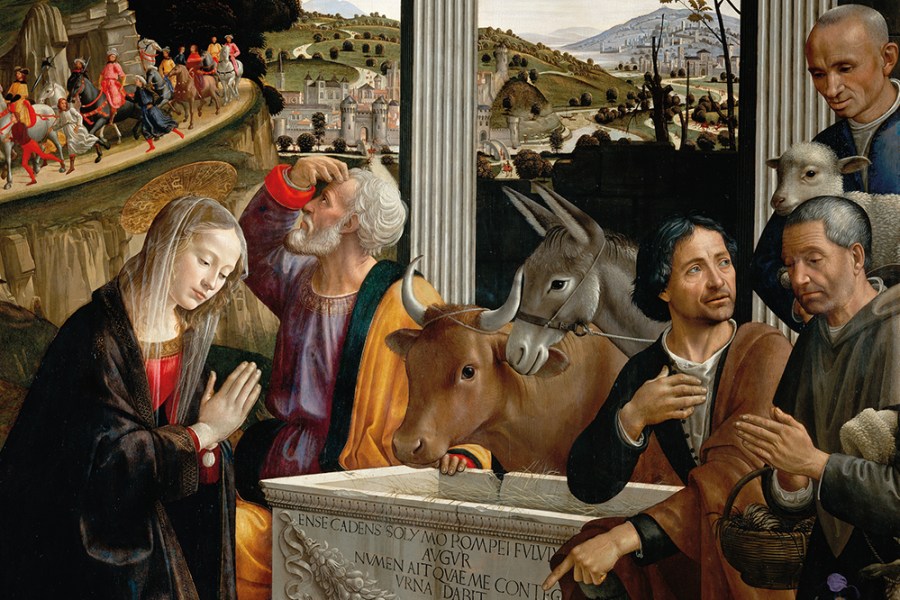
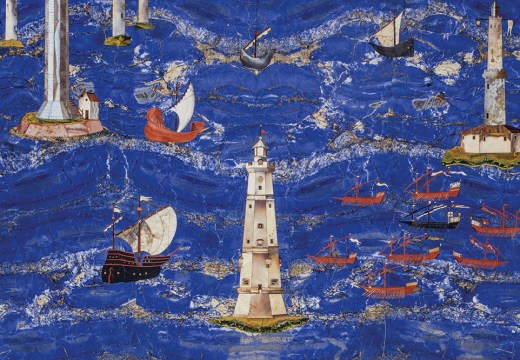
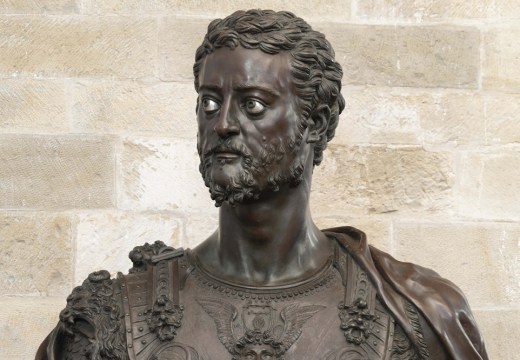
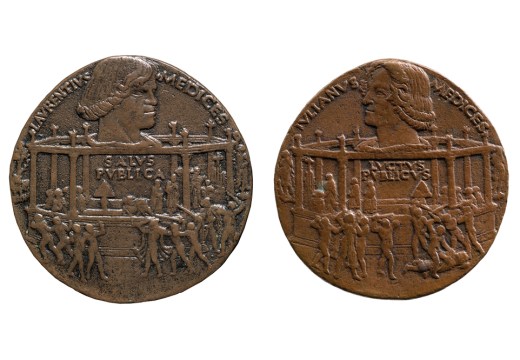









![Masterpiece [Re]discovery 2022. Photo: Ben Fisher Photography, courtesy of Masterpiece London](http://www.apollo-magazine.com/wp-content/uploads/2022/07/MPL2022_4263.jpg)
It’s time for the government of London to return to its rightful home